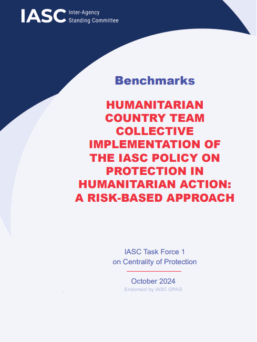This report marks the first IASC-commissioned independent review of how the collective humanitarian system addresses protection. It provides insight into the ability and commitment of humanitarian actors and the humanitarian system to effectively counter behaviors that pose the biggest threats to life for people affected by crisis. The Whole-of-System Review examines how protection issues are addressed in the context of humanitarian action and makes practical suggestions to help humanitarian actors be more strategic, and better capable of meeting core life-saving humanitarian responsibilities in relation to protection.
The key recommendations encompass establishing an operational understanding of protection in practice, emboldened leadership, coordination which is conducive to positive partnerships, and holistic analysis and strategic planning to advance protective outcomes for people affected by crises.
The report specifically looks at whether the current system can effectively achieve protection outcomes. A results-based approach to protection is highlighted within the report and several of the recommendations emphasize the key elements that support results. These include:
- Adopting a “whole of caseload” approach and strategic response plan that addresses contextualized risks, patterns of harm, and coping mechanisms of all at-risk groups and individuals;
- IASC policy on protection and an Explanatory Note to operationalize the definition of protection should include:
- Individual and community self-protection measures and coping mechanisms
- Timely joint assessments and analysis based on early warning, informational management mechanism and secondary data where necessary must be the basis for strategic prioritization
- An articulation of synergies sought with stakeholders including local and national authorities as well as human rights, development, diplomatic and UN peacekeeping other entities/constituencies
- A results-oriented approach
- Monitoring and Evaluation: IASC GPC TT should adopt a results-oriented approach to protection that identifies intended outcomes at the strategic and operational levels
- Resource allocation (including human and financial) is necessary to achieve protection outcomes.
- The findings of the report showed that the current practice of three and six month project funding for UN agencies partners is not conducive to protection outcomes. There is a need to ensure strengthened humanitarian-development partnership and coordination on protection through better utilising existing in-country resources including civil society networks, clearer division of roles and responsibilities in relation to environment building activities and more efficient use of respective resources to deliver outcomes.



